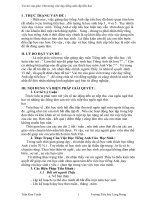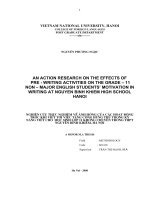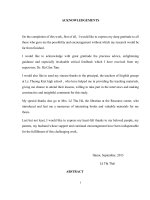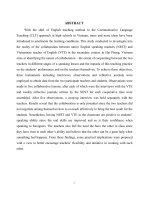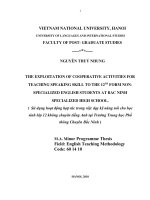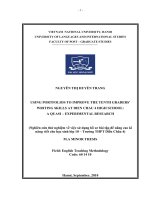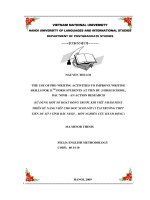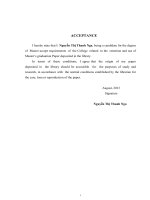Nghiên cứu những khó khăn của giáo viên trong việc dạy kĩ năng viết cho học sinh lớp 11 tại một trường THPT ở bắc giang
Bạn đang xem bản rút gọn của tài liệu. Xem và tải ngay bản đầy đủ của tài liệu tại đây (271.47 KB, 55 trang )
ACKNOWLEDGEMENTS
On the completion of this work, first of all, I would like to express my deep gratitude to all
those who gave me the possibility and encouragement without which my research would be
far from finished .
I would like to acknowledge with great gratitude the precious advice, enlightening
guidance and especially invaluable critical feedback which I have received from my
supervisor, Dr. Hà Cẩm Tâm.
I would also like to send my sincere thanks to the principal, the teachers of English groups
at Ly Thuong Kiet high school , who have helped me in providing the teaching materials,
giving me chance to attend their lessons, willing to take part in the interviews and making
constructive and insightful comments for this study.
My special thanks also go to Mrs. Lê Thu Hà, the librarian at the Resource center, who
introduced and lent me a numerous of interesting books and valuable materials for my
thesis.
Last but not least, I would like to express my heart-felt thanks to my beloved people, my
parents, my husband whose support and continual encouragement have been indispensable
for the fulfillment of this challenging work.
Hanoi, September, 2013
Lê Thị Thái
ABSTRACT
i
In an attempt to investigate teachers’ problems in teaching writing skills to 11graders at a
high school in Bac Giang, the study was aimed at finding out: (1) the problems the
teachers might encounter in the teaching process of the skills; (2) factors causing their
difficulties.
The study has been conducted in the form of a survey research, with the subjects were 6
English teachers . The classroom observation was the main instruments employed for the
data collection. These teachers were also invited to join interviews. The research reveals
that teachers’ time management and teaching methods should really be taken into
consideration. Besides, the data from the study confirm the fact that the students’ laziness
and negative attitudes towards writing lessons all made it difficult for the teachers in
teaching process. In addition, large size classes with multi-level students are also made the
situation worse.
For those reasons, the study finally recommends some implications to help improve the
quality of teaching and learning writing.
TABLE OF CONTENT
ii
DECLARATION i
ACKNOWLEDGEMENTS ii
ABTRACT iii
TABLE OF CONTENT iv
PART ONE. INTRODUCTION 1
1.1. Rationale 1
1.2. Aims of the study 2
1.3. Scope of the study 2
1.4. Methods of the study 2
1.5. Organization of the study 3
PART TWO. DEVELOPMENT 4
CHAPTER 1. LITERATURE REVIEW 4
1.1. An Overview on Writing 4
1.1.1. Roles of writing in teaching and learning foreign language 4
1.1.2. Approaches to teaching writing 5
1.1.2.1. The controlled to free approach 5
1.1.2.2. Free writing approach 6
1.1.2.3. The paragraph-pattern approach 6
1.1.2.4. The grammar syntax organization approach 6
1.1.2.5. The communicative approach 7
1.1.2.6. The process approach ………………………………………………… 7
1.1.3. Writing teaching procedures 8
1.1.3.1. Activities in teaching writing………………………………………… 8
1.1.3.2. Stages in teaching writing…………………………………………… 9
1.1.3.2.1. Pre- writing 10
Brainstorming 10
Planning 10
Debating 10
iii
Interviewing 11
1.1.3.2.2. While- writing 11
1.1.3.2.3. Post- writing 11
1.1.4. Principles for teaching writing 11
1.1.5. Review of previous studies on teaching writing 14
CHAPTER 2. THE STUDY 18
2.1. Research question 18
2.2. Research design 18
2.2.1. Participants 18
2.2.2. Data collection instruments 19
2.2.3. Data collection procedures 22
2.3. Data analysis and discussion 22
2.3.1. Classroom observation 22
2.3.2. Interviews 29
2.3.3. Teachers’ difficulties in teaching writing to the 11
th
grade students 34
PART C.CONCLUSION 37
1. Major findings 37
2. Implications 37
3. Suggestions for further study 39
REFERENCE 40
APPENDIX I
APPENDIX1 I
APPENDIX2 X
iv
PART ONE: INTRODUCTION
1. Rationale
Writing has always been regarded as an important skill in the teaching and learning English
as a Foreign Language (EFL). On the one hand, it stimulates thinking, compels students to
concentrate and organize their ideas, and cultivates their ability to summarize, analyze, and
criticize. On the other hand, it reinforces learning in, thinking in, and reflecting on the
English language. However, writing is considered a difficult skill as students find
composing in English not easy, many students complain that they lack ideas and cannot
think of anything interesting or significant enough to write. While most English teachers
are often perplexed by these problems in their writing classes, they have to face many
challenges and cannot find an efficient way to teach effectively.
English is a compulsory subject and it is one of six subjects in the national examination
that students have to take to get General Certificate of Secondary Education (G.C.S.E) at
secondary school. Since the New English Textbook Tieng Anh 10, 11 and 12 were in use,
besides teaching grammar and vocabulary, four skills such as reading, speaking, listening
and writing have been focused. Among these, writing seems to be a rather difficult and
boring skill as students do not find the lessons given by teachers interesting and attractive
enough to take part in and therefore, students do not work with high motivation, they are
in class but their mind are absent.
Being an English teacher at a high school for over ten years, I have been deeply aware of
challenges in dealing with the interest but demanding subject of English, especially with
writing skill, it has urged me to seek for a suitable teaching writing method to help my
students overcome the problem of lacking “inspiration” in learning writing and create
something for them to write. Besides, not many researchers have been studied the
difficulties of teachers in teaching writing at high schools. Hence, it is an urgent need for
me to take a serious look at such issue and find a place for writing skills in teaching and
learning among teachers and students.
1
For all the above-mentioned reasons, I would like to devote my time researching the topic
in my thesis: “ A study on teacher’s difficulties in teaching writing skill to the 11
th
grade at
a school in Bac Giang”. I hope that my work can help teachers of English have a better
look on teaching writing skills and consult some recommendations in order to improve the
quality of teaching and learning writing skills at my school and elsewhere.
2. Aims of the study
This research is designed to have an insight into the English writing lessons for the 11
th
form students at a high school in Bac Giang province for continual improvement. Within
this purpose, the specific objectives of the study are:
• To identify the teachers’ major difficulties in teaching writing skills
• To examine the causes of their difficulties
3. Scope of the study
The study is mainly focus on the difficulties that teachers confronted in teaching writing
skills to 11 grade students in the classroom setting at a high school. The study of
difficulties of other skills thus would be beyond of the scope. The study involves the
participants of 6 teachers of English and 270 students in 11
th
forms. The findings and
suggested implications most appropriately applied to English teachers at a high school, the
teachers will be able to find ways to improve their process of teaching English.
4. Methods of the study
The study was designed to use a combination of a variety of methods to achieve its objectives.
Firstly, classroom observation with 270 students from 6 classes was carried out to investigate
the reality of the teachers’ difficulties confronting in their teaching writing skills. In addition to
classroom observation, informal interviews with the informants of 6 English teachers were
also employed. The purpose of the survey is to collect data about the teachers’ difficulties in
teaching writing to the 11
th
grade at a high school. Besides, reviewing the related documents is
also a method in order to establish the theoretical background for the study.
2
5. Organization of the study
The study consists of three main parts:
Part one includes the rationales, aims, scope, and methods of the study.
Part two includes 2 chapters
Chapter 1 deals with the roles of writing in language programme, approaches to teaching
writing, writing teaching procedures, principles for teaching writing and review of Previous
Studies on Teaching Writing
Chapter 2 discusses the method of the study, the research questions, the research design,
the data analysis and discussion.
Part three concludes the major findings of the thesis, offers some implications for better
teaching writing skill and suggestions for further study are also pointed out.
PART TWO : DEVELOPMENT
CHAPTER 1. Literature Review
3
1.1. An Overview on Writing
1.1.1. Roles of writing in language program
Writing, like speaking, is the productive skill in the written mode and it is more
complicated than it seems at first and involves more than just using words.
In the process of learning a foreign language, writing is considered an integrated skill
approaching to language learning, especially, writing serves a variety of pedagogical
purposes in the early stages towards oral proficiency, Byrne (1979:7) points out that:
(i) Some learners, especially those who do not learn easily through oral
practice alone, feel more secure if they are allowed to read and write in the
language.
(ii)Written work serves to provide the learners with some tangible evidence
that they are making progress in the language.
(iii) Writing also provides variety in classroom activities, serving as a break
from oral work, and increases the amount of language contact through work
that can be set out of class.
(iv) Writing is often needed for formal and informal testing.
Teaching and learning writing is of great importance in classroom, White (1981, p.1) states
that learners expose their success in examination through their ability to write. Moreover,
writing has high “face validity” because it is tangible so parents and learners can see what
has been done.
In second language learning, the teaching of writing also aims at correctness of form over
function. According to Nunan (2003:89), “writing was used to show that students had
mastered a particular grammatical rule, rather than had a good idea about the subject
matter. In fact, correct spelling, grammar, and overall organization were the most important
evidence of second language proficiency. A student’s ability to form and write the future
4
perfect tense correctly was seen as evidence of a student’s ability to write, and moreover,
of the student’s overall English ability”.
In CLT, besides communication is the purposes of the teaching of writing, writing
supports students to learn. Raimes (1983:3) assumes that the grammatical rules, idioms and
vocabulary will be reinforces through practising writing, in addition, students will get the
chance to go beyond what they have just learnt to say, they are aware of using new
language, show their effort to express ideas, therefore, their language learning is
improving.
With all the roles mentioned above, writing is no double an integral part in almost every
language programs from elementary to tertiary level.
1.1.2. Approaches to teaching writing
There have been several approaches of teaching ESL/EFL writing, they all have advantages
and disadvantages. Ann Raimes (1983,pp.5-10) refers to six approaches to teaching
writing: (i) The Control-to-Free Approach, (ii) The Free-Writing Approach, (iii) The
Paragraph-Pattern Approach, (iv) The Grammar-Syntax-Organization Approach, (v) The
Communitive Approach, (vi) The Process Approach.
1.1.2.1. The Control-to-Free Approach
This approach emphasizes 3 features: grammar, syntax, and mechanics, writing is
considered as a reinforcement for speech. The Control-to-Free Approach in writing is
sequential, students at lower level are first given sentence exercises, then paragraph to copy
or manipulate. Sequentially, students have little chance to make mistakes and the teacher’s
job is quick and easy. Only at high or advanced level are students allowed to try some free
compositions, in which they express their own ideas. In short, accuracy is emphasized in
this approach rather than fluency, thus students are likely to have good grammatical
competence and low communication skills.
5
1.1.2.2. The Free-Writing Approach
Concern for “audience” and “content” are seen as important in this approach, students are
encouraged to write without worrying about grammar and spelling. This approach
emphasizes more on content and fluency than accuracy, the teachers do not correct these
short pieces of free writing; they simply read them and perhaps comment on the ideas the
writer express. Writing a journal or a diary might be useful in this approach.
1.1.2.3. The Paragraph-Pattern Approach
The Paragraph-Pattern approach stresses on paragraph organization. Students copy a model
paragraph, analyze its form and imitate model passages. Students need to invest time to
organize their ideas such as scrambles sentences are put into a paragraph, general and
specific statements are identified, topic sentence is invented or sentences inserting or
deleting.
1.1.2.4. The Grammar-Syntax-Organization Approach
Unlike the Paragraph-Pattern Approach focusing mainly on organization, the Grammar-
Syntax-Organization Approach stresses on both simultaneous work and on organization of
an essay. Students learn writing which can not be seen as composed of separate skills,
therefore, the teachers have to devise writing tasks that lead students to take notice of
organization while they also work on the necessary grammar and syntax. For instance, to
write a clear set of instructions on how to operate a TV set by a remote control, what the
writer needs is not just appropriate vocabulary but the simple forms of verbs, an
organizational plan based on chronology, sequence words like first, second, next, then,
etc. The teachers review and teach these vocabulary and structures in the preparatory stages
and in short, this approach is the connection between the purpose and the form of the
writing.
1.1.2.5. The Communicative Approach
This approach emphasizes the communicative role of writing, students have to focus on the
purpose of a piece of writing (Why am I writing this?) and the audience for it (Who will
read it?). They are also encouraged to write through real life situation and to make the
6
writers do their best, the audience is not only the teachers but the students also become the
readers for each other. They can respond, rewrite, summarize and make comments.
Sometimes, to provide student with a text in which appropriate content, language and level
of formality are selected, teachers specify readers outside the classroom.
1.1.2.6. The Process Approach
The Process Approach emerges when there has a movement in teaching writing from the
concentration on the written product to an emphasis on the process of writing. Student
writers are encouraged to give out their communication of ideas, feelings and experiences.
They not only focus on purpose and audience but also concern how to begin and how to
organize a piece of writing. Writing is a process, so students need to realize what first put
down on paper is not necessarily their product but just a beginning of the first ideas, draft
then revise what has been written after a peer feedback and write other drafts before the
final version is produced.
Writing activities of this approach is paid on a cycle from the generation of ideas and the
collection of data to the “publication” of a finished text:
PRE- WRITING
(Specify the task/ planning and outlining/ collecting data/ making notes)
COMPOSING
REVISING
(Reorganizing/ shifting emphasis/ focusing information and style for your
readership)
EDITING
(Checking grammar/ lexis/ surface features)
There exist several points of views on the number of stages comprising the writing process.
Both Oshima and Hogue (1991) and Tribble (1996) identified four stages in writing
process, however, they are different in activities. For Oshima and Hogue, they are pre-
writing, planning, writing and revising draft and writing the final copy to hand in. Four
7
stages for Tribble are pre-writing, drafting, revising and editing.
In a word, there are various approaches to teach writing skill as mentioned and there is no
single best way to teach writing skill .Thus teachers have to take into consideration many
factors before deciding which approach can be used to suit teaching setting best.
1.1.3. Writing teaching procedures
1.1.3.1. Activities in teaching writing
Generally, we conduct three practical writing activities in teaching a foreign language:
Controlled writing, Guided writing and Free writing
(i) Controlled writing teaching
According to Byrn D (1979), controlled writing activities, at one end of the scale, are
where the learners are given all or most of the language which they have to use. For
example, they may be asked to arrange sentences to form a text or to complete sentences.
Further along the scale, they may be asked to do activities for which they are given help in
the form of “ideas”, for example, through oral discussion, through reading or through
visual materials.
With this type of writing it focuses on practising precisely a certain vocabulary and
structures. The learners are expected to learn how to write correctly by being obliged to
write correctly. Activities can be supported are transformation, filling in the gaps or
sentence completing…etc.
(ii) Guided writing teaching
Guided writing activities are made by the teacher’s attempt to isolate the various
difficulties involved in the production of a text and to present these gradually to the
learners in a systematic way. They do not place so much stress on the production of correct
sentences. Many approaches attempt to phase out or at least reduce the amount of control,
either by forcing the learners to exercise some sort of meaningful choice or by allowing
them to contribute to the text in some way.
Students do the writing tasks under the guidance of teachers, they cannot use language to
communicate freely with the readers because this is not a communicative writing type.
Two main exercises teachers can give students are answering the questions to form a
8
paragraph or making paragraph using given words.
(iii) Free Writing teaching
Students write about any topics by using language to express their ideas, there is no need to
give them the outline or given words. However, the teachers have to conduct three stages
such as: Pre-writing; While-writing and Post-writing if they wish their students to obtain
necessary skills in writing.
1.1.3.2. Stages in teaching writing
According to Brown (1994), there are two main stages in writing teaching: Pre-writing and
While-writing. These stages are a combination of different approaches, especially the
communicative approach and the process approach.
According to Hoang Van Van (2006), there are three stages in teaching writing skill: Pre-
writing, While-writing and Post-writing.
1.1.3.2.1. Pre-writing
In this stage, teachers have to do some following tasks:
+ Exploiting model text by asking students to read the text in order to analyze type
of text to find out vocabulary, structures and tenses which are used to support the purposes
of the writing.
+ Providing necessary words and structures relating to topic by using open-guided
techniques to remind what students have learned and teach how to use what words or
structures they haven’t known.
+ Conducting brainstorming activity in groups or whole class which helps students
to exchange, share their ideas among them. The purpose of this activity is to provide
students something to write.
Tribble (1996) states that pre-writing can be defined as any structural experience that
influence active students’ participation in thinking, talking and working on the topic under
the focus in a writing lesson. In other words, it is the “information-gathering phase in the
process of writing” ( Scarcella & Oxford, 1992, p.125).
Pre-writing is a very important stage of the whole writing process, and the task at this stage
may include deciding on the purpose, the audience, the content and the general outline (Gu
9
Yue Gou, 1990, p.170).
White and Adrnt (1991) briefly categorized pre-writing activities into three types:
generating, focusing and structuring activities.
In the view of Bryne (1988), pre-writing activities like brainstorming, outlining, debating,
interviewing, etc. help students generate ideas and develop fluency
• Brainstorming
Raimes (1983) states that brainstorming, a technique with its purpose is to initiate some
sort of thinking process. The writing assignment is mainly based on – a reading, picture,
textbook topic, personal experience…- it can be preceded by student talk, especially by
brainstorming activity which produces vocabulary, structures and gives chance for students
to ask questions, make associations freely in a short time.
• Planning
According to Coffin et al. (2003), planning is an orientation for students to have logical
sets of ideas that would be later employed in their pieces of writing. Students spend time
organizing, focusing ideas and outlining their writings in groups in this stage.
• Debating
This activity involves oral debates where students discuss in groups and argue in two sides
of topic. In this stage, oral debates not only provide the opportunity to improve some
writing skills such as planning, selecting, marshalling and organizing ideas but also help
them make judgments about the relevance and logicality of their ideas in order to make
wise choice of which ideas to be used to compose a text.
• Interviewing
Ideas are found out through interviewing among students, this is an useful technique
because it creates a relaxed atmosphere when students write the record of interviews. It
also makes writing more enjoyable and interesting.
1.1.3.2.2. While-writing
Hedge (1988) considers the while-writing stage as “composing”, after specifying the task,
10
planning and outlining, collecting data, students begin to compose; White and Arnt (1991)
sees it as “drafting”- the first version . Tribble (1996: p.14) takes during while-writing
stage as “writers are in dynamic interaction with” (1) “the idea for their writing” (2) “their
probable readers’ expectations”, and (3) “ the model of the genre they are currently
composing”
After having outline for the task, students start writing individually or in pairs and groups.
1.1.3.2.3. Post-writing
Revising and editing after composing is an integral part of the writing process (Hedge,
1988). There are two main post-writing activities: the first are self-revision and self-editing
(Harmer, 2003), the second is rewriting based on the feedback or comment from the
teachers or their peers (Harmer,2004).
In this stage, teachers can get feedback from students’ writing by collecting their works,
however, teachers should help students find mistakes and correct by themselves and should
not focus much on students’ error.
1.1.4. Principles for teaching writing
Any teachers teaching English in general and teaching writing skill in particular have to
consider principles while giving a lesson. According to Nunan D (2003), there are four
principles for teaching writing. First, teachers should understand their students’ reasons for
writing because when the teacher’s goals do not match the students’, which will cause the
great dissatisfaction. Second, teachers should provide opportunities for students to write
since writing is in part a physical activities and it requires lots of practice to improve.
Third, teachers have to make feedback helpful and meaningful, this means that teachers
should be cautious about the tone of their comments and make sure they understand the
vocabulary or symbols. Last, teachers should show how students’ writings will be
evaluated.
Byrne D (1979) mentions some principles for teaching writing and the author focuses on
the needs of the learners:
(1) The learners have to be taught how to write, the ability to write is all too
often assumed, especially if the learners are mature.
11
(2) The learners have to be exposed to the written form of the language and to
appropriate varieties. Writing has to be preceded and accompanied by wide
exposure to appropriate models of written language
(3)The learners have to be shown how writing functions as a system of
communication. They need to be shown that any piece of writing, whether or
not it is addressed to a specific reader, has a communicative purpose.
(4)The learners have to be taught how to write texts because writing involves
the ability to organize sentences into a coherent whole or text.
(5)The learners have to be taught how to write different kinds of texts.
(6)The learners have to be set realistic writing tasks
(7)The learners have to be supported in their writing tasks
(8)The learners’ efforts need to be viewed sympathetically
Various approaches to teaching writing have been mentioned and no single method is the
best way to teach writing skills. It depends on many factors such as the school system, the
text or the students’ types. Here are the two most popular approaches used in ESL/EFL
classroom, namely Product Approach and Process Approach.
(i) Product Approach
Product Approach is considered a largely “prescriptive and product-centered” way of
teaching writing. This approach focuses on the final outcome and only needs students to
produce one writing version of the task. It is summarized as follow steps:
← - Imitate model text
← - Organization of ideas
← - Produce the product individually
(ii) Process Approach
On the contrary, Process Approach focuses on the process rather than the final product.
This approach encourages students’ communication of ideas, feelings and experiences. It
also focuses more on purpose, theme, text type, the reader is emphasized, thus, writers not
only concern about purpose and audience but also have to make decision on how to begin
and how to organize a piece of writing. Writing is the process, student are given time to set
12
out ideas, make plan, write a first draft, revise what has been written after a peer feedback.
Brown (1994, pp. 335 – 336) points out some features of Process Approach as follow:
(1) focus on the process of writing that leads to the final written product
(2) help students understand their own composing process
(3) help them to build repertoires of strategies for prewriting, drafting, and
rewriting
(4) give students time to write and rewrite
(5) place central importance on the process of revision
(6) let students discover what they want to say as they write
(7) give students feedback throughout the composing process as they attempt
to bring their expression closer to attention
(8) encourage feedback from both the instructor and peers
(9) include individual conferences between teacher and students during the
process of composition.
When teaching, teachers normally use techniques drawn from other approaches as those
techniques are useful in the context of the class. The writing lessons in new English 11
textbook were combined both Product Approach and Process Approach. This Combined
Product Process Approach is found to be more popular, appropriate and effective. The
outline suggestions for a writing lesson of this approach may be :
Stage 1: Teacher gives a model
Stage 2: The model is exploited through its typical features, language and structures
are used
Stage 3: Students produce an outline after working to find out the ideas for the
writing topic
Stage 4: Students write the first draft individually/in pairs/in groups. The model is
used for comparison
Stage 5: Students exchange and read and comment on each other’s work
Stage 6: Drafts are returned and improvement are made based upon peer feedback
Stage 7: A final draft is written
13
Stage 8: Final draft are exchanged once more; students give responses or reply to
each other
Stage 9: Teacher gives feedback
1.1.5. Review of Previous Studies on Teaching Writing
Many teachers take the view that teaching writing skill is often fraught with difficulties.
Writing, in fact, can be time-consuming, difficult to teach and a great number of English
teachers feel themselves not qualified to teach writing as they have not received enough
specific training in the teaching of writing. The problem is compounded by the fact that so
many prospective teachers lack confidence in their own writings, they often avoid teaching
writing skills and because they do not feel comfortable with writing. Therefore, how
teachers can take actions in order to overcome these problems, researchers and teachers
within the language learning field have been paying considerable attention to the
development of learning strategies. Much research has been conducted to investigate the
effects of strategy training on improving productive skills such as writing. Of the studies,
articles create ideas which are crucial to foreign language teaching and learning
Brainstorming is a useful technique in the first stage of writing lessons. Mentioning the
effects of training in brainstorming strategy on learners’ performance and perceptions
about writing, Zhenhui Rao , argues that EFL teachers should move from a product-based
approach to a process-focused approach in the teaching of writing as the latter may
contribute towards activating students’ thinking and creating ideas for a writing task and
organize raw materials in a logical order. The findings of the study imply that the
brainstorming strategy instruction is effective in improving students’ writing performance
with its three advantages. First of all, the brainstorming strategy prompts students to think
aloud and call out what they have read and heard in English while the teacher works as a
facilitator or guide, hence students become confident and productive in their English
writing practice. In addition, the brainstorming technique encourages students’ active
involvement in the classroom activity and offers the opportunity for students not only to
interact with each other but also to share others’ opinion, as a result, students can cultivate
14
their linguistic and communicative competence and develop their ability to express
themselves in English. Finally, the brainstorming strategy makes students aware of their
intellectual strengths and limitations as it can keep students mentally alert, put them to
learn from each other, overcome weakness and think about how to improve their writing
ability in future practice.
Like brainstorming activity in the first stage of writing lessons, feedback is also essential to
the writing process and is of great importance in the third stage – post-writing, and a large
quantity of research has been carried out to investigate the effects of feedback, especially
teacher feedback which is helpful to students in improving their composition. However,
traditional way in which teachers make comments on the students’ drafts is not effective in
improving students’ writing. Paul Rollinson has taken this problem into consideration.
According to the author, teachers should choose to use peer feedback in the ESL writing
classroom because peer readers can provide useful feedback and revise effectively on the
basis of comments. It also “fosters a myriad of communicative behaviors” (Villamil and de
Guerrero 1996). Peer response operates on a more informal level than teacher response,
this may encourage or motivate writers and the writer receiving comments from peers
retains the right to reject comments. However, using peer feed back which gets time
constraints as the peer response itself is a lengthy one due to reading a draft, making notes
etc. will consume a significant amount of time. With the same concern, Wang Xiang finds
that the technique of self-monitoring, by giving students control over the feedback they
receive, enables teachers to provide effective feedback. The results show that students can
be trained to use self-monitoring in their writing, which is an effective way for students to
improve the organization of their compositions and is especially helpful to higher-
proficiency learners as students annotate their texts with any doubts they have during the
writing process so that the teacher can give feedback not only on the finished draft but also
on the queries which emerged during the writing process. In addition, it encourages
students to look critically and analytically at their writing and to place themselves in the
position of readers.
15
Among difficulties EFL teachers usually put up with, the problem of providing adequate
resources to simulate students in learning writing skill cannot be out of intention. With
much concern about enhancing students’ enjoyment of the writing tasks, while Taylor M.E
in the article titled “ Using collateral material to improve writing performance” proves that
the provision of selected collateral material can improve students’ writing performance.
The enrichment material may be books, magazines, newspapers, or materials created by the
teacher for the purpose of enriching the main materials of instruction. Shin, S.J finds the
use of journals will improve not only teachers’ work but also students’ writing. Taylor,
M.E assumes that students can be encouraged to write better if easily accessible resources
are provided. However, the author states that mere provision of collateral material does not
guarantee improvement. Students need to be taught how to work independently to balance
the demands of those competing interests which affect the quality of their writing.
In language teaching, teachers have to think much of students’ English competence to
design a suitable lesson and teaching low proficiency EFL students to write whole text is
often fraught with difficulties. In order to provide students with the ability to recognize
textual and linguistic features that are used to construct and shape whole texts, groups of
authors including Firkins,A; Forey,G; Sengupta,S state that the genre approach can be an
effective way to teach writing to students who have difficulty organizing texts, generating
ideas, and applying meta-cognitive skills. The genre-based approach is based on a
teaching-learning cycle where strategies such as modeling texts, joint construction and
independent construction are promoted, which is realized to be suitable to deal with low
English proficiency that is typically found. The authors also demonstrate how they
combined, modified, and applied a positive learning environment for students who are
generally stereotyped as underachievers.
In conclusion, numerous aspects are taken into consideration when teaching writing skills,
they are students’ English competence, approaches and activities teachers use as
brainstorming, peer feedback, materials, etc,. All of which are of great importance in
improving the teaching and learning writing.
16
CHAPTER TWO: THE STUDY
This chapter discusses the design of the study line with its research questions. Research
design consisting of participants, data collection instruments with classroom observation
form and interview questionnaire is also included. Research design also touches with data
collection procedures which introduce how the data collection has been carried out. The
data are analyzed and discussed thoroughly from classroom observation and the questions
for interview in order to find out the difficulties teachers encounter in teaching writing skill
to support research questions.
Both quantitative and qualitative methods are employed to carry out the study. With the
aims of increasing validity and reliability of the data collected, the teachers’ lessons are
observed to help researcher have real insight into the current situation of teaching writing
skill. Informal interviews with teachers are also conducted to confirm the data collection.
2.1. Research question
What are teacher’s difficulties in teaching writing skill to the 11
th
grade? And why?
17
2.2. Research design
2.2.1. Participants
This study was conducted at a school where English is compulsory subject. The school has
been founded for 11 years and in school year 2013-2014, there are eight 11
th
grade classes.
The participants chosen for the study are 270 students from six eleven-forms groups
(11A1, A2, A3, A4, A6 A8). Most of 11
th
grade students at aged from 16 to 17, both male
and female, have learnt English at least 6 or 7 years but in different levels, some students
are good, and many are not. They have the similar background, that is, they all come from
countryside. At the time of the study, they were in the first term of the school year 2013-
2014.
There are 6 teachers of English, four of them are teaching grade 11 at present. All of them
have been teaching English at least 6 years, one has got M.A degree, five have got
Bachelor Degree. Two are following M.A courses. They are all female, their ages range
from 28 to 36.
2.2.2. Data collection instruments
Data for this dissertation were collected through classroom observation, interview and
described in the following section:
Classroom observations
Classroom observations were strictly conducted with two different lessons, each lesson
lasted forty-five minutes. The first lesson was Unit 1 with the writing topic “Write about a
friend”. The aims of the lesson were to help students know how to write a description. In
this writing task, students were requested to describe the characteristics and personalities of
one of their friends, students revised vocabulary relating to the topic to describe one’s
appearance and personalities. This is not difficult task for students to write because many
words relating to the topic had been taught in speaking lesson. The second lesson was
18
observed with the writing topic “Writing a personal letter about a past experience” in Unit
2. The aims of the lesson were to revise the past tenses, to help students know how to write
a letter and describe what they experienced, where, when, how and who involved in. The
writing task is considered more difficult task as students had to use their own words to
show their expressions, they not only had to learn the form of a personal letter but also
described what had happened, which was really a challenging task because of their
limitation in vocabulary. The two different lessons were attended with different types of
writing topic in order to clarify and test techniques the teachers used in three stages in
teaching writing: pre-writing; while-writing and post-writing and to find out whether the
aims of the lessons were achieved, which bring about a better look at the reality of teaching
writing skill and the challenges the teachers encounter in class.
Classroom observation form
Date:
Class attended:
Length of period:
Writing topic:
Objectives of the lesson:
Procedures of
the lesson
Teacher’s activities Students’ activities Time
Warming-up
Pre-writing
stage
19
While-writing
stage
Post-writing
stage
(i) Interviews
The interviews were conducted right after the lessons were attended. The questions were
designed based on what was observed in the lessons. The aims of the interviews were to
confirm what was found through teachers’ activities. Because teachers used various
techniques among them in the writing lessons and so the questions for each teacher were
different. Here is the list of the questions
List of the questions
Question 1: Do you think eliciting is a good technique to revise necessary words for the
writing topic? And do you conduct the techniques properly?
Question 2: Did you provide enough vocabulary and structures for students to write?
Question 3: Do you know the reason why many students were not engaged in the lesson?
Question 4: Do you think time was well-divided among stages in your lesson?
Question 5: Do you find your students having difficulties in writing? And what are the
causes?
Question 6: Why wasn’t peer-correction used in your lesson?
Question 7: Why didn’t you give chance for your students to rewrite their drafts which
20
must be done in a writing lesson?
Question 8: Are your students in the same or different level? How difficult is it when
you teach multi-level students in a class ?
Question 9: Why were there only pre-writing and while-writing stages in your lesson?
Question 10: Do you think you achieved the aims of your lesson? Are you satisfied with
your lesson? Why? / Why not?
2.2.3. Data collection procedures
The study was conducted through classroom observation on the first three weeks. The
permissions to attend teachers’ writing lessons given to the eleven grade groups in different
classes were made. Each teacher was attended two lessons with two different writing topics
among the classes they are teaching. While observing, the procedures and the techniques
carried out by teachers were noted down carefully and how long these activities conducted
was included, too. The classroom observation was reported in the four stages of a writing
lesson: warming-up, pre-writing stage, while-writing stage and post-writing stage. In each
stage of the lessons, the problems or difficulties emerged were jotted down. Before the
interviews with teachers were conducted, the nature of the research and the purpose of the
interview which aims at confirming the information while observing were explained and
how the data used were also informed to the interviewees.
2.3. Data analysis and discussion
In this part, the research results will be presented on the basis of the information which was
collected from classroom observation and interview. First, it will consider how teachers
conducted steps in their lessons, what techniques they used, the ways they carried out
21
